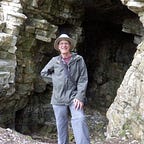Do We Really Make Decisions — Do We Shape Life or Does Life Shape Us?
How we answer this question affects not only the way we understand life, but also the degree to which we hold ourselves responsible for what happens to us.
Here it may help us to take a step beyond our immediate human concerns and consider what a tree, for example can tell us about decision-making.
It’s a helpful example, because a tree actually records its life experience in its bodily form: its branching pattern, its leaf and bud scars, its growth rings, its healed and unhealed wounds.
When we examine this record, how do we interpret it?
Do we view it retrospectively, from an objective distance, as the outcome of a series of right or wrong executive choices made in advance, with its branches in competition with one another to succeed? This would lead us to conclude that past life determines future life via sequential cause and effect. Applied to ourselves we might then see our past history as a record of favourable decisions to take credit for and faulty decisions to be blamed for. Sound familiar? How often do we look back with hindsight at our past life and either wish we had or hadn’t decided to do or say that, or bask in the satisfaction of what has turned out well? This is how many of us have been led to think, mechanistically, about our successes and failures in life. And it is deeply embedded in the notion of ‘natural selection’. But, if in reality life forms are sentient, internally motivated inclusions and expressions of their habitat, not lifeless mechanical objects driven into motion by external force, how true to real life is it?
What if instead we understood the tree’s growth form as the outcome of its ongoing sentient receptive response to its current local situation? As such, it both emerges from some singular material source (its germinating seed) and is called forth into an as yet immaterial and changeable future of many possibilities by the varying availability of sunlight, water, minerals and air that it needs to sustain its life. At the same time it is exposed to potentially damaging influences that it needs to withstand and recover from. What we now see is the tree not as an isolated material ‘figure’, but as a dynamic configuration of its spatial and energetic ‘ground’ or ‘context’, which adds onto and sheds from its existing structure as it continuously enters its future. There has been a shift in our perception beyond predictable singular mechanical cause and effect to multidirectional and ultimately unpredictable situational influence. As the tree materializes into shape, it doesn’t so much choose its future from a set of known options, as commit receptively and responsively to the call of a particular possibility. And, actually, although purely mechanistic science is unable to admit it, in so doing it is manifesting the same relational pattern of behaviour that is known to quantum mechanics as ‘wave-function collapse’.
So, next time you castigate yourself or someone else for what you or they have done wrong, or feel discontented with the way your life has turned out, try asking not who is to blame but how has this happened? Then you may also recognise how dangerous hindsight (‘post-hoc rationalization’) can be when it leads us to overlook and/or cut our selves adrift from what truly brings us to life, within, throughout and all about us. And then it may also be possible to recognise what can enable us to live in a far more contented, truthful, creative, compassionate, egalitarian and sustainable way than many of us currently do.
For further exploration of the evolutionary process of ‘natural inclusion’, please visit my personal website at http://www.spanglefish.com/exploringnaturalinclusion.
Addendum
In the reality of the natural flow geometry of current time within and around continuously receptive space, intangible future possibility precedes tangible past actuality, just as tangible past actuality precedes tangible future actuality.
Hence to disregard the intangible is to create the illusion that material past causes material future. While to disregard the tangible is to create the illusion that all we actually experience is in the mind alone.
